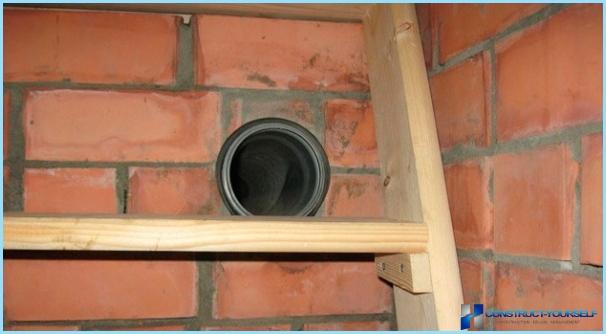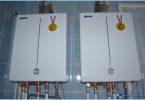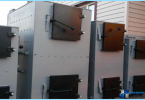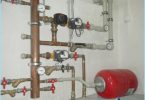The contents
Ventilation of the cellar is a very important point in the equipment basement. Most of the owners of cellars in garages and private homes are faced with the problem how to make proper ventilation in the cellar, if the stored food quickly starts to fall apart. Often this is due to initially wrong-crafted ventilation.
What should be the ventilation ↑
Like it or not, proper ventilation in the basement garage will protect your building from many unpleasant factors. Without it, the vegetable pit begin to be covered by the condensate, which in the end will negatively affect all stored indoors, vegetables and products. The most common are mildew, mold and rot smell. Cold air goes down one tube, and hot comes out the other.
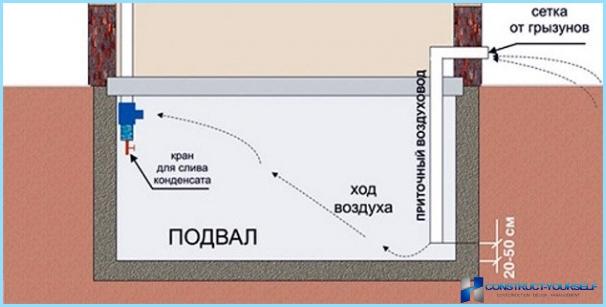
In the winter season, when heat from the earth dominates the heat from the outside, in the basement garage are created particularly adverse conditions. Because in such conditions the vegetable pit will have the ability to create corrosion on the car body and various car parts followed by the release of moisture. But this can be easily avoided if you properly install ventilation.
Interestingly, the ventilation of the cellar in the garage can occur naturally under proper difference cold/hot air in the room or when using an auxiliary fan. As for the top of the pipe, she needs to look up over a basement.
Pick up a hood for a specific property type ↑
Reasonably-chosen system of ventilation will allow the cellar in the garage to deal effectively with the emergence of any adverse factors. For this purpose, as a subsidiary element, set up supply pipe, which creates a large influx of fresh air. Most importantly, why you should install the air duct is an opportunity to get rid of excessive moisture and toxic substances.
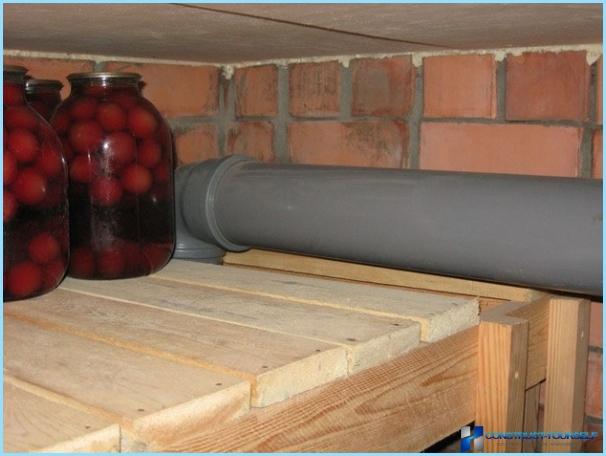
Air circulation helps to maintain normal humidity in the room.
The most appropriate solution for the cellar in the garage is to install a system of supply and exhaust ventilation. This can be done in the following ways:
- The first option is to create a natural ventilation in the basement. This is a very popular method, because in such a case, homeowners install only two pipes – supply and exhaust. The system operates thanks to the proper temperature difference inside and outside the cellar. Especially in the winter season. But everything is not so simple. As the hood tend to become clogged under the influence of heavy precipitation of snow and frost. Also, as for the other seasons, it is not easy. Due to the stabilizing of the temperature on one level, the heat stops, so in the summer from this system good almost there. Therefore, this hood is recommended only for small basements, which is designed primarily for use in the cold season.
- The second system is a forced ventilation of the cellar in the garage. Is a better choice than the previous version. Its main advantage is the creation of a climate close to the street. This is achieved through the use of auxiliary fan units. Often, such a system includes the use of a pair of tubes or one double pipe.
If we compare natural ventilation, the first wins due to its availability, and the second due to the covered square.
Natural extractor ↑
Installation of ventilation in the basement of a private house or garage is a difficult task, but there is a way to do it very easily. For this purpose, in the wall to make a channel section not exceed the size of one brick. You need to install the reinforced mesh of metal to the cellar was protected against the ingress of bugs and insects through this channel.
When mounting natural ventilation in the basement garage with your own hands is extremely important not to forget about the rules and regulations which must be adhered to when installing any exhaust. The tips outlined below will help you to preserve its durability and strength:
- It must be remembered that the calculation of ventilation in the basement of a private house or garage, proceeds from the norm, which is 1 square meter needs 25 square centimeters cross-section diameter of the duct.
- The dimensions of the channels for the inflow and outflow of air must be the same.
- The height of the pipe above the roof will affect the intensity of inflow of air into the room. To maximize thrust, you must set it to a distance of 80 cm from the roof.
- Use the deflector to enhance the efficiency of air exchange. This apparatus creates a region depleted of air inside the pipe that also has a positive effect on the breathability.
- Due to the fact that the deep pipes can enter all kinds of insects and rodents should wear protective bars on the input channels.
?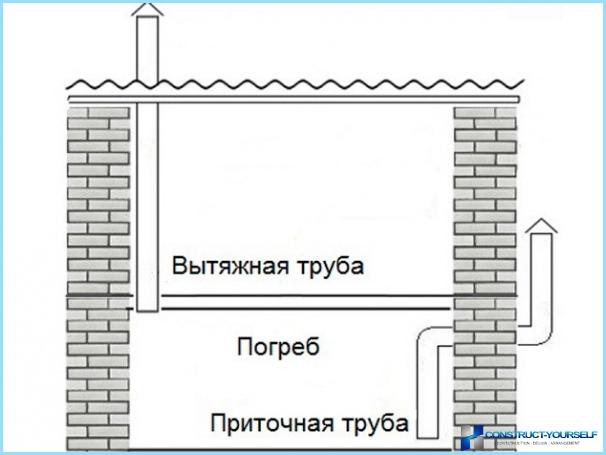
As a rule, the organization of natural ventilation consists of installing the two pipes in opposite corners of the cellar, each plays a role. The first will be responsible for the flow of air, and the second for outflow. This system works in any basement located under the garage, or private home.
As you can see, natural ventilation of the cellar in a private house or garage is a very simple and affordable way to create a favorable climate in the garage. This system is not highly productive, but it is much better than the complete lack of ventilation.
Installation of natural ventilation: ↑
- The ventilation in the basement with the help of this system consists of two pipes. The exhaust pipe should be installed into the wall so that its inner end is at a distance of 150-200 cm from the floor, and her outer part to withdraw on the roof about the height of 35-50 cm.
- Regarding the supply pipe, it must be locked in the opposite corner at a height of 40-45 cm from the floor. The outer part needs to come out for a distance of 25-35 centimeters. Don’t forget that this channel must be protected by a grille. Also will not be superfluous and installation «hats» from falling rain inside the pipe.
To regulate the air flow in the cold season, when it is necessary to prevent possible freezing of products, it should advance to install mounting the damper inside the vent pipe.
Interesting. To somehow reduce the cost of installation of ventilation in the basement, you can eliminate the use of supply pipe, making only the channel in the lower part of the wall for air flow, block it with a grid. Enough air came in to the basement.
The creation of artificially-forced ventilation ↑
Artificial extract is nothing like extra fans in the ventilation channels. The creation of such a system is not difficult. Its main advantage is the self-regulation optimal climate in any season regardless of the temperature difference.
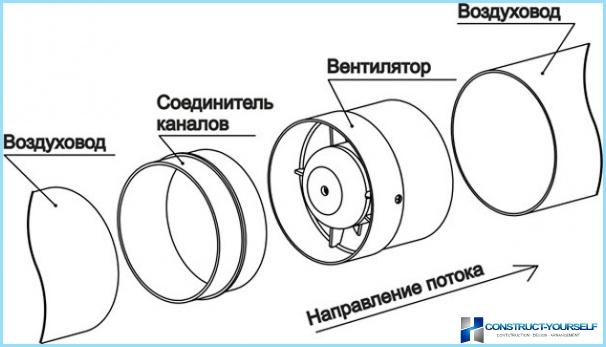
The scheme of installation of the duct fan
The principle of forced ventilation almost does not differ from the arrangement of natural ventilation for the cellar in the garage or a private home. It was also based on a typical installation of the air pipes, only with the addition of inside themselves fans. This system is able to provide a constant circulation of clean air anytime, thus protecting all your products from the process of decay for a long time. Note that such a system can be organized not only thanks to the fans.
Similar methods of forced ventilation of the cellar with their hands: ↑
- The use of rotary displacement of the weather vane. This mechanism operates under the influence of air flow. Setting it to hold at the upper end of the supply pipe.
- To achieve effective ventilation in the cellar and the basement is also possible through the use of deflectors. This device creates a region of rarefied flow ventilation, which contributes to the evasion of ventilation. Installation to be carried out at the end of the supply pipe.
- «Grandfathers» the way to install incandescent bulbs in the chimney. Such a clever way to reinforce the hood, thanks to the heated air stream which will enter into the room.
- Fan built into the chimney.
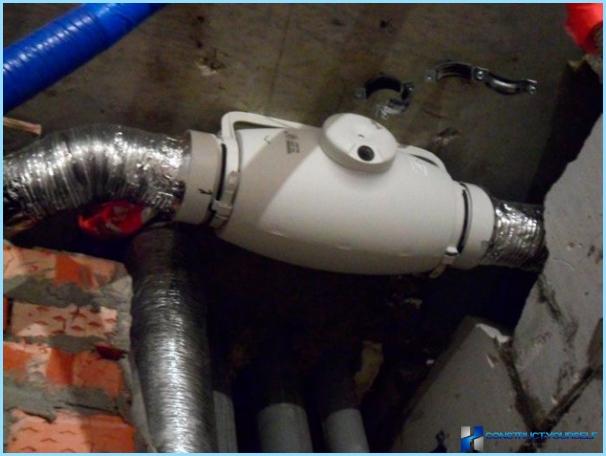
The most advanced method of ventilation of the basement is undoubtedly the use of monoblocks. This mechanized device that uses a digital component in its Arsenal for self-regulation of the climate inside the building. This is the highest quality option for the ventilation of basements. From shortcomings it should be noted only by its high price.
Conclusion ↑
What can you say about these types of ventilations. Each is good in its own right. The most common type of ventilation among avid gardeners and owners of garage premises, of course, is natural ventilation because of its relatively low cost. Despite this, more rational will be the use of artificially-forced ventilation. Its pricing is not as high as it seems at first glance, but in terms of usefulness, even without the use of fans and auxiliary systems it will still create an optimum room climate. In any case, any ventilation is better than none. So the choice is yours.

